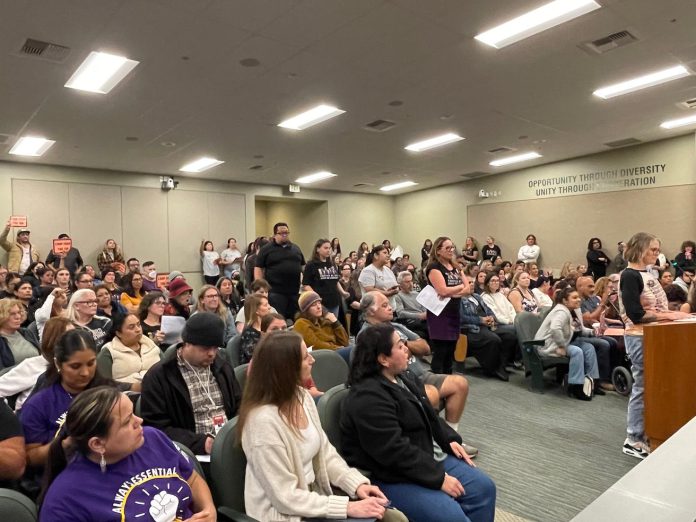
In the middle of more than an hour of public comment Wednesday during the Pajaro Valley Unified School District Board of Trustees meeting, Gabriel Barraza—a frequent critic of the district—gave a quote he said is well known in public administration.
“Show me your budget, and I’ll show you your values,” he said.
The line became a common theme during the contentious meeting—which lasted well past midnight—when the board discussed a list of recommended layoffs to help stave off a projected $15 million shortfall by laying off more than 150 teachers and other school employees.
A frequent refrain from more than 50 speakers was criticism that administrators had recently been given raises, even as possible layoffs loomed.
“When you are padding cabinet-level positions, when you are giving raises to the superintendent and other administrators, and you are cutting from the people who are on the ground, doing the work to educate, to make our students feel safe and heard, that says a lot about your values,” Barraza said.
The trustees took no action during the meeting. They will revisit and finalize the layoffs on Dec. 11.
District officials say the need for the staff reductions comes after $127.5 million in one-time state funding that came in 2020 during the Covid pandemic dried up.
This is coupled with declining enrollment that is expected to last through the 2027-28 school year.
Assistant Superintendent of Human Resources Kit Bragg said the district lost 450 students this year, and estimates that 500 will be gone next year, which amounts to a $13.5 million loss.
In addition, the lower number of students means low classroom ratios, with PVUSD schools averaging 18 students per teacher.
“We can’t afford staff at these ratios,” Bragg said.
PVUSD Chief Business Officer Gerardo Castollo referenced a letter sent from the Santa Cruz County Office of Education stating that the district is deficit spending by more than $10.4 million this year, $15.4 million next year and $17.7 million in 2027-28.
If that keeps up, he said, PVUSD could face eventual takeover by the state.
“And that is something, believe me, we do not want to do,” he said.
Bragg said the district could also consider closing some schools—a complicated process that can take up to a year. Other options include increasing class sizes, implementing furloughs and restructuring the district’s benefits plans, all of which must be negotiated with teacher and school employee unions.
On the chopping block
The list of recommended layoffs included 15 counselors, about 11 reading intervention teachers, 2 behaviorists, 13 mental health clinicians, 10 healthcare assistants, 15 instructional assistants, and 40 special education teachers. In addition, the proposed plan would eliminate 50 temporary, probationary and intern teachers.
Public outcry
Hundreds of people packed the Watsonville City Council Chambers, with more than 50 addressing the board for more than an hour, all of whom implored the board to look for alternative ways to save money.
Many decried plans to slash special education and counselor positions.
Amesti Elementary School teacher Rachel Hitchcock questioned why upper-level employees were recently given raises when teacher layoffs were a looming possibility.
“If the budget is in such dire straits that educator and support staff cuts need to be made, why are the people who are already making the most money getting raises,” she asked.
Trustee Misty Navarro said that the $15,000 salary increase for superintendent Heather Contreras, who earns $275, 921 a year, was an agreement baked into her contract by the previous board.
“This was an obligation we already promised over a year ago,” she said.
“I wish we had unlimited funds and that we could do all things for all people, but we have to make really hard choices up here, and none of us were looking forward to this meeting,” Navarro said.
Michael Christensen, whose son is in special education, said that his teachers are an essential part of his education.
“These people are saints to us,” he said. “They give a chance for our kid to have a voice, he’s growing, he’s thriving, he’s doing all these incredible changes that would not happen at the private level. And now to hear all these cuts are going to happen, these really are… to the most vulnerable.”
Speaking through a Spanish translator, Maria Campos asked the board to reconsider cutting counselors, explaining that two of her family members who attempted suicide were saved by the help they received.
“Thanks to (the counselors), they’re alive today,” Campos said, adding that the board’s decisions will be “the difference between life and death and the future of many students.”
Aptos Junior High School teacher Suzanna Langstaff said she relies on the school’s behavioral technicians, instructional assistants and behaviorists.
“Please do not cut the individuals who work with our students, who make their futures possible,” she said.
Other options
Castillo said that the district can look for ways to boost attendance.
“We get paid only if our students attend school,” he said. “If they don’t attend school, we get paid nada, zero.”
While selling district-owned properties was presented as another option, Castillo stressed that those proceeds would be one-time funding that should not be used for ongoing salaries.
“To generate revenue we have very limited options,” he said.
The district could also look to parcel taxes, he said.
Trustee Gabriel Medina questioned why the district is considering cutting counselor positions with a recent spate of student suicides and assaults, without first considering cutting consultants, the Lozano-Smith law firm retained by the district, outside training and “executive perks.”
“We had a loss of 4 to 5 student lives to suicides, and you don’t think that we actually need counselors now to prevent that from happening more,” Medina asked.
Bragg said that the district has 41 counselors on staff, and that cutting 15, which were hired with the one-time Covid funding, would still allow the district to have counselors at the school sites.
“In order to deal with the reductions that have to take place, and the fiscal shortfalls that the board has to wrestle with, if we don’t release those teachers, then we have no way to right-size because we don’t have positions to put them into.”
Medina also asked whether the district could tap into its reserve funds to help make up the current shortfall.
While the district is required by the state to maintain a 3% reserve to weather financial crises—roughly $10 million—it currently has about $46 million in that account, Castillo said.
“We have $46 million, we need $15, and we have to have $10 million,” Medina said. “What would be the shortfall?”
Castillo responded that such a move would leave the district unable to pay its bills within three years, which Medina called a “budgetary assessment.”
Board President Olivia Flores read a letter from the SCCOE outlining the district’s obligation to keep a healthy balance, and said that the board should look to realistic solutions.
“The fact is that we do have a $15 million deficit spending problem that we need to fix,” she said.
Superintendent Heather Contreras said the district has closed 130 classrooms this year, which saved an estimated $2-$5 million.
Trustee Joy Flynn asked district administrators to go to Watsonville city officials and to the Santa Cruz County Sheriff to ask them to cover the cost of school resource officers.
“I think that would be a really loud commitment to the future of our students and PVUSD, and show a community response and community responsibility,” she said,
Flynn also asked the district to look into what the savings would be to close schools.










